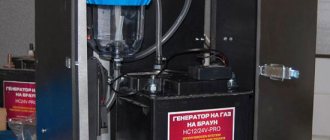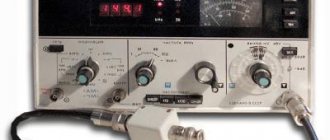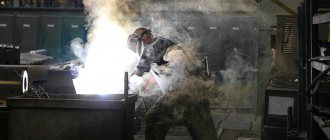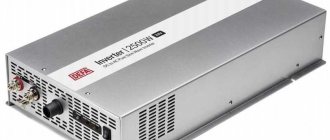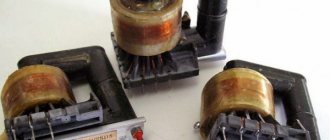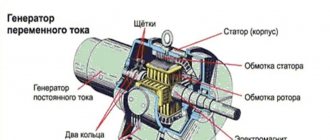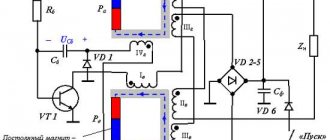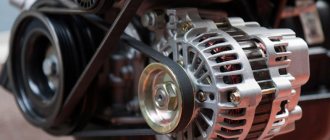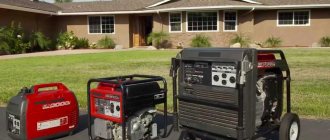In professional activities and at home, inverter generators are used for welding work. Many people have such devices today. In this article we will look at what an inverter generator means.
Essentially, it is an electronic unit that converts direct current into alternating current. It is not difficult to understand the structure of an inverter generator: it consists of a stator, with windings and a rotor located on it. The latter is equipped with several poles with electric or permanent magnets. Due to the rotation of the rotor, a magnetic field is created that penetrates the stator winding. As a result, a voltage generated by the generator appears in the stator.
Diagram of a classic electric generator without inverter technology Source club.dns-shop.ru
How does an inverter generator work, what is the difference with a regular one?
The principle of its operation, in contrast to the standard one, is that during the processing of fuel (gasoline or diesel), high-frequency alternating current is generated, which is immediately converted into direct current and transferred to the battery, where it is accumulated.
Compared to an inverter unit, which has a low noise level during operation, the standard unit is very noisy and emits exhaust gas.
A portable generator is a mobile diesel or gasoline device, some of the models are hybrids. Their engine can operate on several types of fuel, for example: a mixture of gasoline and propane.
Additional functions
Modern stations should have three mandatory functions:
- Economy mode.
When the equipment is turned off, it automatically reduces engine speed. As soon as the devices are reconnected, the generator automatically returns the desired speed value. - Oil level sensor.
Automatically turns off the gas generator when the oil level reaches critical values. - Internal protection.
Prevents damage to the gasoline station by turning it off in case of a short circuit or exceeding the permissible load.
In addition to the above, FUBAG inverter stations are equipped with a digital display. Using it, it is easy to control the main operating parameters - output voltage, alternating current frequency, engine hours worked and rpm value (engine speed).
TI's lineup also uses an unusual fuel cap. It has a valve that prevents fuel from spilling out.
Voltage characteristics of inverter generator
Power parameter - 0.8 - 0.9 kW; fuel - gasoline; The output potential is single-phase, 220 V. The voltage waveform is sinusoidal with minor distortion. The quality of the sine wave is affected by the level of harmonic curvature, the permissible value is 8%.
The difference between conventional and inverter generators Source planeta-instrument.com.ua
Compactness
We have already focused on the small dimensions of the device.
Inverter generators are indeed much more compact and lighter than their traditional counterparts. When comparing FUBAG power plants, we can give the following example: the classic 2 kW BS model weighs as much as 40 kg, and an inverter device of the same power weighs only 22 kg, which is almost 2 times less.
As a conclusion, the inverter device is easy to carry even in one hand, which makes it extremely convenient for hiking and outdoor activities.
What to choose: a classic or inverter generator?
Living in a country house in the conditions of Russian reality is associated with certain difficulties. This mainly has to do with power outages. The problem is solved by purchasing an independent source of electricity - a generator.
The number of models manufactured by manufacturers on the market is great. In this article we will look at some features that will help home owners in purchasing a generator set. Sequence of steps:
- First, determine the total power consumption for the entire house.
For each owner, this figure will be purely individual. On average, one cottage requires about 10-15 kW of electricity. For a summer house, 2-5 kW is enough.
- Select generator type.
The units are: regular diesel or gasoline, inverter.
Diesel generator AMPEROS LDG 3600 CL Source gaspowersystems.com
Standard generator
The electric current it produces is crude, not entirely pure. Its parameter is very different from the value indicated in the passports of household appliance manufacturers. For this reason, it is not advisable to use conventional generators to power high-precision electronics. However, such units have a number of advantages:
- Wide selection of power models.
Manufacturers produce from the smallest of 1 kW to large powers of 9-10 kW. There are industrial designs from 20 to 100 kW. However, they are not suitable for domestic use due to excess power.
- Easy to use.
The generator is easy to operate if you follow the operating conditions established by the manufacturer.
- The price is cheaper than inverter models.
Due to their availability, stationary generators are in demand on the market today.
Operating rules
When operating generators, you must follow the following rules:
- It is prohibited to use a generator driven by an internal combustion engine in enclosed spaces;
- after stopping operation, it is necessary to cool the installation, since the engine and parts of the exhaust system heat up to high temperatures;
- Fill the tank with fuel in the open air and when the unit is cold;
- when refueling there should be no open sources of fire nearby;
- electrical networks and connection to the generator must comply with the rules of the PUE;
- do not leave the generator running in the rain and do not touch the operating unit with wet hands;
- Before stopping the engine, let it run without load for several minutes;
- Carry out regular maintenance in accordance with the manufacturer's recommendations.
If the operating rules are followed, the inverter generator will not cause problems for the owner and will save you from expensive repair work.
Video description
Weaknesses, disadvantages of inverter generators.
In addition to the advantages, there are disadvantages:
- There is a limit on the permissible load.
Conventional devices cannot be used if the total load is less than 25%, but it is also undesirable to exceed more than 75%.
- With low power of connected devices, fuel consumption is almost the same as when operating at full capacity.
- Noisy generator operation.
- Emission of exhaust gases.
- For the room where the generator is installed, it is necessary to remove exhaust gas particles through the laying of a separate air line.
Air duct systems for removing exhaust gas particles Source astklimat.com
If the unit runs on gasoline, it is not recommended that the engine be operated at constant speed. This condition greatly affects the quality of the generated electricity. Frequent breakdowns of installations occur precisely when this recommendation is not followed.
Inverter generator
These units are suitable for providing electricity to complex stationary equipment that requires a stable voltage: computer devices, heating boilers, various controllers, electronics.
Inverter generators have a number of advantages:
- Characterized by stable electrical parameters.
- Load level affects fuel consumption.
In case of partial load, when operating at low speeds, a little gasoline is consumed.
- Weight and dimensions are small.
You can take such a unit with you to any event held geographically far from civilization. For example: hunting, fishing, hiking.
- Low noise level during operation.
In the event of an emergency power outage in a residential building that has many household appliances, it is best to connect an inverter generator. Repairing and purchasing new equipment that burned out during a sudden power surge will be slightly more expensive than the price of the generating set.
Disadvantages of the inverter:
- High price.
In stores it costs approximately 1.5 - 2 times higher than a stationary generator of the same power.
- It is not possible to repair individual parts.
If any element fails, you need to purchase a new generator.
- The maximum power of the inverter unit is 6 kW.
It turns out that if there is a need for a constant source of electricity for buildings, construction sites, or there is a need to organize emergency lighting, then it makes sense to buy a standard generator.
When operating at full power, such a unit will last a long time. In this case, no repairs will be required, and additional costs during the period of its operation are also unlikely. If you use only high-quality fuel and carry out timely maintenance and oil changes, the service life of the generator will significantly increase.
Maintenance and installation of Elitech generators Source elitech-tools.ru
If it is necessary to solve two problems at once: in case of emergency and as a constant power source, then it is optimal to use a combined solution. With this option, standard and inverter generators operate simultaneously.
How to calculate the required power
Choosing a generator based on power is a responsible matter. The reliability of the home’s energy system, as well as purchase costs, depend on the correct calculation of the parameter.
How to calculate the power of a generator for a home? It is required to add up the consumption of all devices that will be connected to it. This is not the main power source, so only the most necessary devices are connected to it.
What power generator is needed in this case? For an average home, 5–6 kW is usually enough. If there are fewer consumers, for example, there are no pumps, the refrigerator is not connected (modern models can be offline for up to a day), then 2–3 kW will be enough. If you only need to support volatile heating, 1 light bulb and recharge a mobile device, then 1 kilowatt is enough.
For example, what can be connected to a 3 kW generator? At the same time, it will pull a medium-sized refrigerator, a light bulb or a modern TV, and a heating system circulation pump. Such an electric generator is enough to power an inverter welding machine.
Inverter generator device
The design of the unit, combined into a single housing, includes:
- internal combustion electric motor;
- a generator that produces voltage;
- an inverter unit that converts alternating current into direct current;
- terminals for connecting output circuits;
- control and monitoring unit for technological cycles.
To connect devices, a general industrial output of electrical energy is used through 3 power contacts of a standard socket designed for alternating current 220 V.
Generators are classified according to various parameters.
By design features
Closed. They can work in dusty rooms or outdoors in any weather.
Inverter generator running on gasoline Source yandex.ru
Open. These are usually high-power models that can withstand heavy loads and require good ventilation.
By power
- Portable (1-3 kW).
They weigh up to 8 kg and come in the form of a small suitcase.
- Medium (up to 6 kW).
They weigh up to 100 kg and are made as a monoblock.
- Heavy (up to 8 kW).
They weigh more than 100 kg, these are professional devices, they work under high load conditions.
By launch method
Manual: to turn it on, you need to pull the cable, usually these are cheap models.
Automatic: started by a starter, equipped with powerful units.
By type of output signal (sine wave)
Clean. They are used to supply electricity to high-precision equipment that are very sensitive to power surges: computers, audio systems, medical equipment.
Modified. They are used to power household appliances that are not so demanding on the parameters of the electrical network: refrigerators, televisions, microwaves.
Review of popular models
Model Hammer GNR2000i
Hammer GNR2000i
- Type - power plant;
- Engine - petrol;
- Phases - single-phase;
- Generator type: synchronous;
- Power - 2 kW.
The Hammer GNR2000i gasoline inverter generator with a manual drive and a 5.7-liter tank capacity provides uninterrupted power for 4.5 hours. This device can be installed at the dacha or in country cottages.
In case of unplanned power outages, the portable station will heat the room, provide lighting and provide consumers with the necessary amount of energy for domestic needs. The price of the Hammer GNR2000i petrol inverter generator is 23,596 rubles.
DDE device DPG1101i
DDE device DPG1101i
- Type - power plant;
- Engine - petrol;
- Phases - single-phase;
- Generator type: synchronous;
- Power - 0.8 kW.
This manually operated station with a 2.6-liter tank capacity provides electricity for five hours. The model is perfect for installation in country cottages and providing summer residents with autonomous electricity during unexpected power outages.
The disadvantage of the DDE DPG1101i gasoline inverter generator is the lack of a noise-insulating casing, which does not allow it to be installed directly in living rooms. The price of the device is 8,150 rubles.
Model Hyundai HY 2000 SI
Hyundai HY 2000SI
- Type - power plant;
- Engine - petrol;
- Phases - single-phase;
- Generator type: synchronous;
- Power - 2 kW.
This model of inverter gas generator for gas boilers with manual drive and a tank volume of 4.5 liters provides the circulation pump with power for up to 5.5 hours. A stable supply of high-quality current maintains the functionality of the boiler for a long time and ensures uninterrupted operation of the heating system in the house.
In addition, the power of this inverter gas generator is enough to provide lighting and power to household electrical appliances (TV, hair dryer). To connect large household appliances (refrigerator, washing machine), a device with higher power ratings is required - for example, an inverter gas generator up to 3 kilowatts.
What to look for when choosing
Power
What characteristics should you use to choose a quality device? First of all, you need to determine the purpose of the device: what it will be used for. If you need to connect only a couple of household appliances and a few light bulbs, you need to choose a gas generator of appropriate power: no more than 2 kW. Such devices do not weigh much, and they can be taken on a hike or installed in the countryside.
, medical equipment or pump are chosen with high power characteristics: from 5 kW. Such devices are heavy and are often equipped with wheels for ease of movement. They are capable of providing energy to a large number of current consumers.
Type of current
Power consumers differ in the quality of the current consumed: single- or three-phase. Low (single-phase) power consumption devices include household appliances. Three-phase power is required for such devices as a concrete mixer, compressor, electric boiler and others.
Control type
The type of control of a gasoline inverter generator is of no small importance. What is better - automatic or manual drive? Manufacturers offer several options for controlling power plants: manual, semi-automatic, automatic
In addition, combinations such as manual control from a remote control have been developed. The choice will be up to the consumer. The cheapest option is manual.
Synchronous or asynchronous
Synchronous inverter gas generators produce current with better characteristics and are resistant to short-term network overloads. It is recommended to buy such devices when connecting equipment with high starting current values, as well as household appliances, microwave ovens, etc.
Asynchronous devices cannot cope with high loads, but they can withstand short circuits. It is recommended to buy this equipment for all types of heating appliances: electric stoves, lamps, etc.
Welding inverter generator control
The operating principle of such a unit is based on a 2-fold transformation of the properties of electric current. The generator must have the following functions:
- Fast start.
The arc is ignited at an accelerated pace. Thanks to this, it will be easy for a beginner to obtain a stable flame by slightly increasing the operating current.
- Automatic sticking.
The unit is protected from breakdown in the event of a short circuit during welding: the voltage drops to zero, the current increases to infinity. In such a situation, the inverter circuit automatically turns off the device.
- Arc force.
The current increases for a short moment when the voltage drops to 20 - 25 V. The function is needed for welding thick sheets of steel.
- Voltage stabilization.
It is important when working in conditions of unstable power grids, especially important in rural areas, as well as when connected to an electric generator.
- Temperature regime.
There is a need for use at different air temperatures. Good models allow the unit to operate within the range from - 20 to + 40C.
The principle of operation of the 220 V device is that the welding operating mode (SW) alternates with periodic shutdowns. With a value of PV = 0.6, welding work can be performed continuously for 4 minutes. Then the unit will turn off after approximately 4/0.6 = 6.67 minutes. These parameters are indicated by the manufacturer in the device passport.

